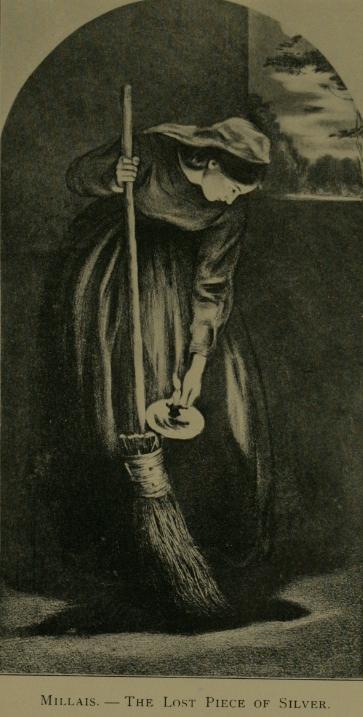
Parable of the Lost Coin
Encyclopedia

Parables of Jesus
The parables of Jesus can be found in all the Canonical gospels as well as in some of the non-canonical gospels but are located mainly within the three synoptic gospels. They represent a key part of the teachings of Jesus, forming approximately one third of his recorded teachings...
. It appears in only one of the Canonical gospels of the New Testament
New Testament
The New Testament is the second major division of the Christian biblical canon, the first such division being the much longer Old Testament....
. According to Luke
Gospel of Luke
The Gospel According to Luke , commonly shortened to the Gospel of Luke or simply Luke, is the third and longest of the four canonical Gospels. This synoptic gospel is an account of the life and ministry of Jesus of Nazareth. It details his story from the events of his birth to his Ascension.The...
, a woman searches for a lost coin. It is a member of a trilogy on redemption
Redemption
- Religion :* Redemption , an element of salvation to express deliverance from sin* Redemption, absolution for the past sins and/or protection from damnation* Pidyon haben, redemption of the firstborn son in Judaism...
that Jesus tells after the Pharisees
Pharisees
The Pharisees were at various times a political party, a social movement, and a school of thought among Jews during the Second Temple period beginning under the Hasmonean dynasty in the wake of...
and religious leaders accuse him of welcoming and eating with "sinners." The other two are the Parable of the Lost Sheep
Parable of the Lost Sheep
The Parable of the Lost Sheep is one of the parables of Jesus. It appears in two of the Canonical gospels of the New Testament, as well as in the non-canonical Gospel of Thomas....
, and the Parable of the Lost Son or Prodigal Son
Parable of the Prodigal Son
The Prodigal Son, also known as the Lost Son and the Prodigal Father, is one of the parables of Jesus. It appears in only one of the Canonical gospels of the New Testament. According to the Gospel of Luke a father extravagantly gives his sons their inheritance before he dies...
.
Narrative
As recounted in LukeGospel of Luke
The Gospel According to Luke , commonly shortened to the Gospel of Luke or simply Luke, is the third and longest of the four canonical Gospels. This synoptic gospel is an account of the life and ministry of Jesus of Nazareth. It details his story from the events of his birth to his Ascension.The...
15, a woman with ten silver coins (Greek drachmae
Greek drachma
Drachma, pl. drachmas or drachmae was the currency used in Greece during several periods in its history:...
) loses one. She then lights a lamp and sweeps her house until she finds it, rejoicing when she does:
Interpretation
Joel B. GreenJoel B. Green
Joel B. Green, Ph.D. is Associate Dean for the Center for Advanced Theological Studies and Professor of New Testament Interpretation at Fuller Theological Seminary in Pasadena, California, United States, and the author of numerous books, most of which are related to the New Testament.He is an...
notes that the woman described is a poor peasant, and the ten silver coins, corresponding to ten days wages, "likely represent the family savings." The coins may also have been the woman's dowry, worn as an ornament. Both theories may be true, and either one explains the urgency of the woman's search, and the extent of her joy when the missing coin is found.
Like the parable of the Ten Virgins
Parable of the Ten Virgins
The Parable of the Ten Virgins, also known as the parable of the Wise and Foolish Virgins, is one of the well known parables of Jesus. It appears in only one of the Canonical gospels of the New Testament...
, this is a parable about women which immediately follows, and makes the same point as, a preceding parable about men. In the Greek, the "friends and neighbors" are female.
Green suggests that the invitation to the "friends and neighbors" may reflect a celebratory meal, which recalls the meals Jesus is accused of sharing with "sinners." The woman's diligent activity in searching may symbolise either Jesus' own activity or that of God the Father. The rejoicing of the angels is understood to be rejoicing along with God.
Depictions
This parable has been depicted by several artists, including John Everett MillaisJohn Everett Millais
Sir John Everett Millais, 1st Baronet, PRA was an English painter and illustrator and one of the founders of the Pre-Raphaelite Brotherhood.-Early life:...
, Jan Luyken
Jan Luyken
Johannes or Jan Luyken was a Dutch poet, illustrator and engraver.-Biography:...
, Domenico Fetti
Domenico Fetti
Domenico Fetti was an Italian Baroque painter active mainly in Rome, Mantua and Venice.-Biography:...
, and James Tissot
James Tissot
James Jacques Joseph Tissot was a French painter, who spent much of his career in Britain.-Biography:Tissot was born in Nantes, France. In about 1856, he began study at the École des Beaux-Arts in Paris under Hippolyte Flandrin and Lamothe, and became friendly with Edgar Degas and James Abbott...
.

